귀하의 세부 정보
귀하의 세부 정보
|
검토자 Andreas Zabczyk
Gemstone Anklets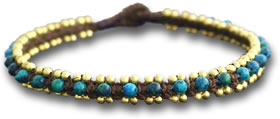 Azurite and Turquoise Anklet with Golden Bells
Although gemstone anklets may seem relatively new in the West, they have actually been worn for centuries in places all over the world. Anklets are bracelets for the ankle and were worn by several ancient civilizations, including the Sumerians of Southern Mesopotamia (modern day Iraq). These were a form of decorative jewelry which were thought to indicate unavailability due to marriage and the level of their husbands' prosperity. On the other hand, in some African tribes, anklets were only worn by single women. Ancient Egyptian women also wore anklets, such as ones with charms, and those with higher social status wore anklets made from valuable precious metals and gemstones such as lapis lazuli. Anklets were also worn by Native American dancers, in Celtic tribes of Northern Europe and are referred to as ornaments in the Bible. 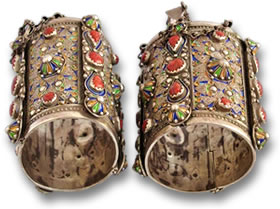 Silver Berber Anklets with Carnelian Gemstones
Anklets can be made from various materials such as leather, hemp, beads or metals. They may be stiff, made from beaten metal in the style of a cuff with a hinge or a gap to enable comfortable wear. They may also take the form of a flexible chain with a clasp. They are usually worn just below the ankle bone and some are adjustable, with others being specific sizes. Anklets can be as simple as a single chain or a string of beads. They are sometimes decorated with shells, gemstones or bells. Indian women have worn anklets for centuries. Anklets continue to constitute an integral part of traditional Indian bridal jewelry. In India, anklets are known as payal, ghungru, paizeb or pajeb. Some Indian anklets have toe rings attached. This trend seems to be taking off in the West, with the emergence of "barefoot sandals", which are a similar style. It is said that the tribal anklets of Rajastani women are the largest and heaviest. Some traditional Nigerian anklets of the Igbo people were also very large, incorporating horizontal plates beaten from brass. 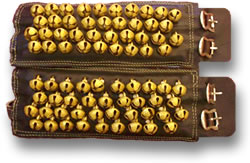 Classical Indian Dance Leather Anklets with Bells
Some traditional Indian dancers wear anklets with bells, which make an attractive sound as the dancers move. Classical Indian dances feature intricate foot movements and anklets draw the viewer's attention to these. It is thought that in some cultures where males and females were traditionally segregated, anklet bells warned men of women approaching. Additionally, some say that anklet bells serve a useful purpose for women working in fields where snakes may move away from such sounds. In some parts of the world, for example in South Asia, anklets were traditionally worn on both ankles and joined by a chain which limited the length of footsteps. This caused women to walk with dainty, "feminine" steps, rather than long strides. In some parts, these were worn by married women. No wonder a wife has been referred to as a "ball and chain", though it seems the proverbial shoe was on the other foot in this case, since it was the women being oppressed rather than doing the oppressing. 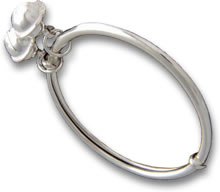 Thai Silver Baby Anklet with Bell
In ancient Egypt, Thailand and some other nations, anklets are traditionally worn by infants. In some nations, gold anklets are given as traditional gifts to newborn babies, such as in Southeast Asia. It is believed by some that gold anklets are thought to provide protection for babies. Some Thai anklets worn by infants have tiny bells attached and are worn on both ankles. This could be so that parents can hear where the child is at all times, or a kind of built-in rattle for children to amuse themselves with. Anklets made from bronze dating back to the Bronze Age have been found in archeological sites in Northern Thailand and in other places including Northern Europe. 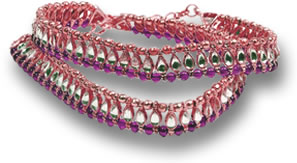 Rose Gold, Amethyst and White Topaz Anklets
If anklets have been around for so long and encompass such a wide variety of cultures, then why are they not very often seen? Anklets were given a bit of a bad reputation in later times, when they were associated with immodesty and hippie attire. However, nowadays, they are seen simply as another item of jewelry that can be worn by anyone. Anklets draw attention to and cause attractive legs and feet to be admired, especially during long, hot summer days. It seems that anklets have been a form of ornamentation for many years and any negative connotations attached to them have come from modern popular culture in the West, rather than the countries in which they have continuously been worn for centuries. |
